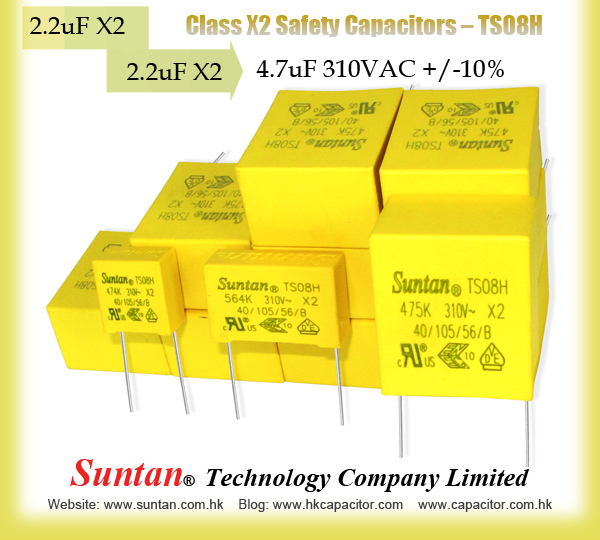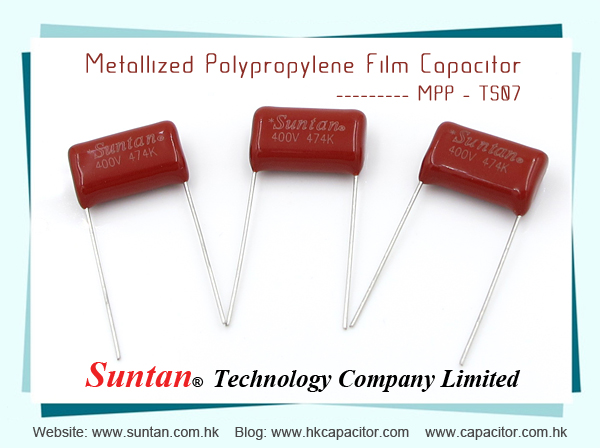Su Suntan Zener Diodes Keep up with Huawei of 5G
Suntan Technology Company Limited

Suntan Technology Company Limited

Suntan Technology Company Limited
----All Kinds of Capacitors
Recently, we successfully proposed our TS08H 310VAC Metallized Polypropylene Film Capacitor - X2 4.7uF to our customer.
Before, our customer used two piece of 2.2uF capacitors in a device, in order to cost down and speed up the operation time, our engineer suggest customer use one piece of 4.7uF capacitor in stead.
We are sure, customer will be satisfied with our proposal.
At the same time, we also can produce below high value capacitors with low MOQ and competitive price.
Most of the Chinese X2 manufacturers can only produce to 2.2uF capacitance, but Suntan is capable to produce up to 10uF Capacitance, Welcome your inquiry.
| Capacitance (uF) | L+/-1mm | T +/-1mm | H +/-1mm | P±1mm |
| 2.2 | 30 | 25 | 14 | 27.5 |
| 2.2 | 41 | 28 | 14 | 37.5 |
| 2.7 | 32 | 28 | 18 | 27.5 |
| 2.7 | 41 | 28 | 14 | 37.5 |
| 3.3 | 32 | 28 | 18 | 27.5 |
| 3.3 | 41 | 32 | 17 | 37.5 |
| 3.9 | 41 | 32 | 17 | 37.5 |
| 4.7 | 32 | 37 | 22 | 27.5 |
| 4.7 | 41 | 33.5 | 18.5 | 37.5 |
| 5.6 | 41 | 37 | 22 | 37.5 |
| 6.8 | 41 | 37 | 22 | 37.5 |
| 8.2 | 41 | 41 | 26 | 37.5 |
| 10 | 41 | 43 | 28 | 37.5 |


Storage—there is never enough of it. I still remember when I thought my 700MB hard drive was huge... until I tried to copy an entire CD onto it for faster access. After that, I spent a period stuck choosing music to stick on my three GB hard drive. Two weeks ago, I ditched six months' worth of simulation data because my 320GB hard drive was full. One TB of new drive later, and I'm wondering how soon it will be before I start feeling the squeeze again. Maybe never, if some of the latest research coming out of Korea and Germany bears fruit.
One of the cool things about hard drive technology is how it has actually kept pace with computer needs. The basic mechanism for hard drive storage, however, does have some fundamental limitations, which manufacturers will have to deal with fairly soon. Bits are currently stored in the orientation of tiny magnets, called ferromagnetic domains, on a hard drive platter. The smaller the domain, the easier it is for that orientation to be scrambled by temperature or stray electromagnetic fields. At a certain size, thermal photons (e.g., heat energy from the surrounding case or the underlying disk) have enough energy to flip a domain's orientation. Manufacturers will have to keep their domain sizes significantly bigger than that threshold size to ensure data integrity, which puts a ceiling on storage density, one we're rapidly approaching.
An alternative is to use ferroelectric domains. Unlike ferromagnetic domains, ferroelectric domains have a natural electric field with an orientation that can be used to represent data. Until recently, these haven't looked that attractive because they have pretty much the same limitations that ferromagnetic domains have, but they lack the cool read-out tricks. Ferroelectric materials, however, do have one big advantage over ferromagnetic materials: they can be used to make really good capacitors. This is exactly what the latest research, published in Nature Nanotechnology, is about.